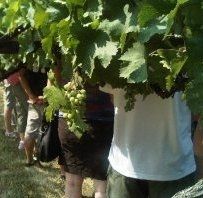Wine enjoys an exceptional level of support from the current state governor of the Commonwealth of Virginia, Robert F McDonnell, and his agriculture secretary Todd P Haymore. Indeed, the latter even took an hour or two out of his schedule on a recent visit to London to make Jancis M Robinson fully aware of this unusual fact in a country where wine until recently has been demonised. They see the development of the state's wine business as a major potential stimulus not just to farming but to tourism, too. After all, they are very much on the itinerary of Civil War tourists. What better than being able to provide them with wine routes as well? As David King of King Family Vineyards put it, 'the busines model here is to bring customers to the winery' (58% of all Virginia wine is sold at the cellar door). And bear in mind that Virginia's pretty rolling wine country is only an hour or two's pleasant drive south west of Washington DC. Visitors to Virginia wineries such as Horton above already number more than one million a year. That said, the state government has a permanent lobbyist on behalf of the wine business and in Virginia winery development is also positively encouraged. Very unlike California.
secretary Todd P Haymore. Indeed, the latter even took an hour or two out of his schedule on a recent visit to London to make Jancis M Robinson fully aware of this unusual fact in a country where wine until recently has been demonised. They see the development of the state's wine business as a major potential stimulus not just to farming but to tourism, too. After all, they are very much on the itinerary of Civil War tourists. What better than being able to provide them with wine routes as well? As David King of King Family Vineyards put it, 'the busines model here is to bring customers to the winery' (58% of all Virginia wine is sold at the cellar door). And bear in mind that Virginia's pretty rolling wine country is only an hour or two's pleasant drive south west of Washington DC. Visitors to Virginia wineries such as Horton above already number more than one million a year. That said, the state government has a permanent lobbyist on behalf of the wine business and in Virginia winery development is also positively encouraged. Very unlike California.
The earliest European settlers, who arrived in Jamestown in 1607, were required by law soon after to plant and tend at least 10 grapevines although, as the most famous Virginian Thomas Jefferson was to find, European wines would fall fatally prey to American pests and diseases. The modern Virginia wine industry set down roots (American rootstocks and European varieties) in the 1970s with the first Chardonnay planted in 1973. By 1995 the state had 46 wineries. Today there are more than 220, making it the American state with the fifth biggest total of wineries.
Total area planted with vines is only just over 3,000 acres (1,214 ha) though (about the same as England, incidentally). There are still about 500 acres of hybrids and 200 acres of American varieties, notably Norton, which is claimed as a Virginia grape, but most new plantings are of European vinifera vines.
The most planted varieties, in declining order, are Chardonnay (470 acres), Merlot (348 acres), Cabernet Franc (310 acres), Cabernet Sauvignon (260 acres), Viognier (230 acres) and Petit Verdot (170 acres) although Vidal, Chambourcin and Norton are also significant and Petit Manseng, which thrives here and its loose cluster helps grapes to resist the humidity, is increasingly important for both dry and sweet whites really remarkably like Jurançon.
A Virginia winery is, typically, located on the tourist trail with vines planted near the winery but grapes also bought in from other growers. For this reason perhaps, much blending. I left Virginia without much grasp of the six sub AVAs Eastern Shore (on a spit sticking out into the Atlantic), Monticello, North Fork of Roanoke, George Washington Birthplace, Rocky Knob and Shenandoah Valley. Most producers seem to use the general catch-all Virginia AVA.
The terrain is dominated by the beautiful Blue Ridge Mountains, which run north-east to south-west and soils are very varied but include limestone, shale, sandstone and red clays on a granite base.
The biggest companies are, in roughly declining order, Williamsburg, Château Morisette, Barboursville, Prince Michel and Horton – although Kluge, recently acquired by Donald Trump, is expected to start making a noise once more. And a newcomer, Rutger de Vink, is expected to make waves for the sheer quality of the first offerings from his RdV Vineyards.
Summers are hot and humid so there are many challenges for vine growers. Many a grape is picked in August but then autumn arrives fairly decisively and it can be difficult to ripen a late-ripening variety such as Cabernet Sauvignon on some sites.
All wines I tasted were made very competently and tended to have refreshing acidity and well handled oak, even if few had real density of flavour. I don't know whether this is because yields were too high, grapes picked too cautiously early or perhaps a more complex viticultural or oenological reason. Viognier apparently holds on to its acidity well here but tends to overcrop. The picture top left shows the lyre canopy for Horton's Rkatsiteli vines immediately in front of the tourist-aimed winery pictured above. 'Our big issue is humidity, which is why we give the vine room to grow in a divided canopy', according to Dennis Horton. He is a great innovator, makes a sparkling version of Viognier, also grows Tannat and Pinotage, and, like one or two other Virginia producers, has developed Xoco, a wine with added chocolate flavours which I must say was not up my street but are apparently hugely popular with many of those million tourists.













